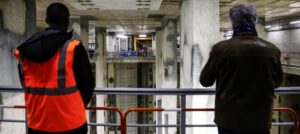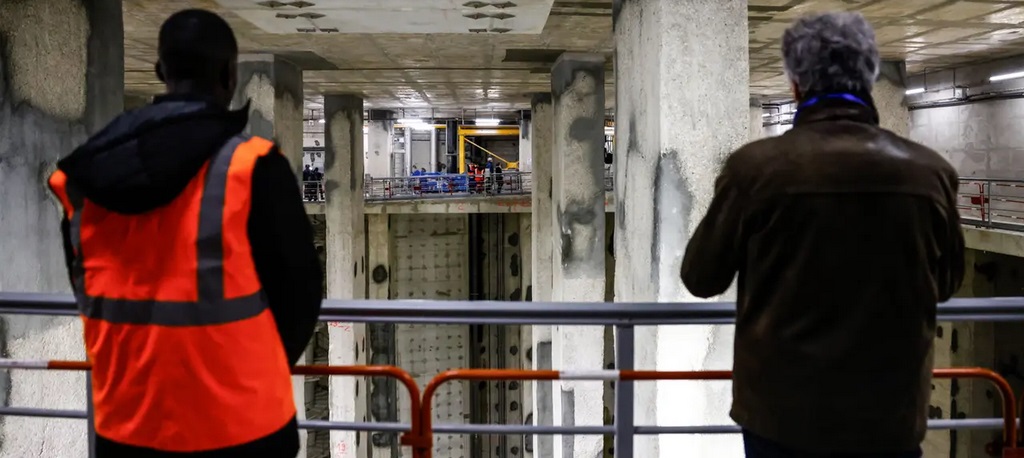 Swimming in the Seine river in Paris is an unpleasant affair, with trash and debris floating through its sluggish waters. A retention basin is being built to purify the water to the point where Olympic competitions can take place in it.
Swimming in the Seine river in Paris is an unpleasant affair, with trash and debris floating through its sluggish waters. A retention basin is being built to purify the water to the point where Olympic competitions can take place in it.
A basin designed to keep the Seine river clean
Swimming in the Seine river in Paris is an unpleasant affair, with trash and debris floating through its sluggish waters. A retention basin is being built to purify the water to the point where Olympic competitions can take place in it.
The testing phase of the project has now begun. If everything goes well, the gigantic retention basin near the Gare d’Austerlitz train station will be operational by summer. Engineer Samuel Colin-Canivez is enthusiastic as he descends into the 30-meter-deep concrete basin. It holds 50,000 cubic meters of water, equivalent to 20 Olympic swimming pools. The purpose of the basin is to collect all the excess water during heavy rainfalls that the Parisian sewer system cannot handle. Colin-Canivez explains, “By collecting the water here, it doesn’t flow directly into the Seine, carrying all the dirt and debris.”
Instead, the water will be held in the basin until the rains subside. It will then be roughly filtered, sent to treatment plants, and only then released into the Seine. This method has been employed in other cities for some time.
Now Paris, the most densely populated major city in Europe, is following suit. The €90 million project is just one part of the masterplan to clean up the Seine river and its tributary, the Marne. The government has spent a total of €1.4 billion to sustainably improve the water quality of this particularly slow-moving river.
Investments have been made in more modern treatment plants and locks. Daily measurements are currently being taken. Hydrologist Jean-Marie Mouchel from Sorbonne University explains that fecal contamination is particularly dangerous, with Coli bacteria serving as a key indicator of water purity.
Wastewater discharge for houseboats
It is crucial that all houseboats on the Seine are also connected to the sewer system – a third component of the “swimmable Seine” project. The so-called “péniches” are charmingly moored along the Parisian quays, such as at the Port des Champs Élysée directly across from the National Assembly. During heavy rains or floods, dead rats can be found on the walkways and an unpleasant soup of garbage can float around the houseboat gangway.
Madame Han Ha has been living on the “India Tango” with her husband for over 20 years. She regrets that the city of Paris only gave them the green light to connect to the sewer system three months ago. The city could never provide clear instructions on how to do it, according to the woman in her mid-fifties. With the upcoming Olympics, there is finally a solution.
The city contributes an additional €4,000 to the €5,000 cost of connection. All houseboats are expected to be connected by July. Madame Ha puts on a raincoat, steps outside onto the quay, and points to a gray box. The wastewater from all boats on the quay is collected there and then led into the Parisian sewer system, a real improvement.
However, during floods, Madame Ha must disconnect the wastewater pipe to prevent damage to the entire system. “In that case, our wastewater does end up in the Seine after all,” she explains with a shrug, looking somewhat puzzled.
Macron and Hidalgo keen on swimming too
Will the project succeed after all? Will events like triathlon, para-triathlon, and swim marathon actually take place in the Seine river? Pierre Rabadan is confident that it will work. The former rugby professional, now responsible for sports at Paris City Hall, has closely monitored the progress of the retention basin near Gare d’Austerlitz over the past months.
Donning yellow rubber boots and with his head tilted back, the athlete stands in the massive concrete basin a few weeks before the start of the testing phase. He assures, “Unless we have multiple days of extremely heavy rain, this basin guarantees that water quality will be maintained, and we can conduct the competitions as planned.”
After the 2025 Olympic Games, swimming spots in the Seine will be opened to all Parisians. Rabadan took the plunge into the river last June, right in the heart of the city where the Olympic opening ceremony will take place. “It was a wonderful moment,” he recalls. “Enjoying Paris, its panorama of structures and monuments, while swimming, will be a unique experience for everyone!”
Both Mayor Anne Hidalgo and President Emmanuel Macron have already announced their intentions to swim in the Seine before the Games’ opening.

